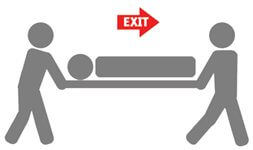Organizing Evacuation Chaos: Coordinating the Movement of Patients

When Hurricane Sandy made landfall in October of 2012, 14 US states and Washington, D.C. were impacted. It was the second-costliest hurricane in US history after Katrina. The storm spanned 1,100 miles, killing at least 233 people along the path of the storm in eight countries. In New York City alone, the storm was the direct cause of 43 deaths and thousands of injuries. Hospitals in the area, along with various government agencies, evacuated 6,300 patients from 37 healthcare facilities. Some of these evacuations occurred during a planned undertaking while others happened emergently during the height of the storm without power or utilities to help guide their way.
An evacuation requires time, labor-intensive resources, and support at levels that most healthcare facilities don’t possess for routine emergencies. A key factor in the evacuation process, especially when patients are earmarked to leave the facility, is the coordination of patient movement based on the evacuee’s proximity to the threat, mobility level (walking, wheelchair, or stretcher-bound), and degree of illness acuity. When a decision is made to evacuate patients, they should not be moved simultaneously from their rooms, or bottlenecks will occur.
Role of the Evacuation Branch Director
The individual in charge of the evacuation, commonly referred to as the Evacuation Branch Director, requires a stream of data to begin orchestrating the process. This information includes the number of patients to be moved, their location and mobility level, the site of designated holding areas on each floor, and the location of specific loading areas at the level where deportation will occur. In addition, the Evacuation Branch Director and support team require real-time information on receiving facility bed availability, accessible transportation assets and their arrival times, and the capacity of each loading area. By documenting this constant flow of information on specifically designed worksheets, the Evacuation Branch Director can begin orchestrating the evacuation in a timely and efficient manner.
Example Evacuation Scenario
For example, staff in the Evacuation Operations Center (EVoC) receives information from the Planning Section that Community Medical Center can accept 20 patients with acuity appropriate for a Medical/Surgical floor. The Logistics Section relays to the EVoC that 30 EMS vehicles are staged at the Stretcher Loading Area. With this information at hand, the Evacuation Branch Director orders the Evacuation Group Supervisors on 3 South and 3 West to begin the horizontal movement of 10 stretcher-bound patients each to their designated Holding Areas.
As the patients begin arriving at the Holding Area, the Evacuation Branch Director communicates with the Vertical Movement Unit Leader to begin coordinating the movement of these patients to the Loading Area near the emergency department ambulance bay. As the evacuees begin to arrive at the Stretcher Loading Area, the Patient Tracking and Accountability Team Member documents their arrival, the transportation vehicle assigned, their destination, and their deportation time. While this is occurring, the Evacuation Branch Director continues to receive information into the EVoC about receiving facility capacity and availability of transportation assets to continue the evacuation procedure.
A partial or complete hospital evacuation is a high-risk procedure commonly performed in a background of chaos. It must be performed in an efficient and highly coordinated manner in order to move the greatest number of people in the least amount of time. The timing of patient movement on particular floor is determined by incident leadership, and is dependent upon a series of tasks that must be carried out on each effected unit in a standardized and methodical manner.
DQE’s Evacuation Support & Supplies
Evacuation readiness requires ongoing staff and leadership training supported by a planning document, evacuation process, documentation and tracking forms, and logistical aids designed to work in unison to safely coordinate the movement of patients in a timely manner. DQE’s online and onsite training, planning, and support tools are designed to help hospitals implement a safe and efficient evacuation capability.
